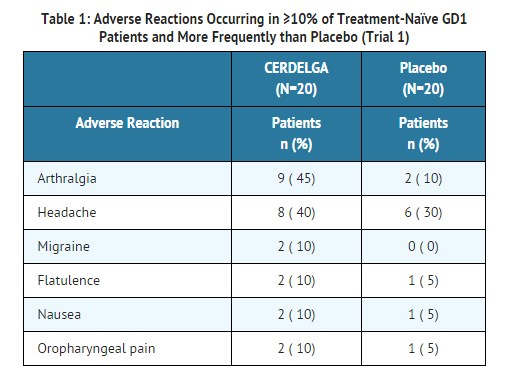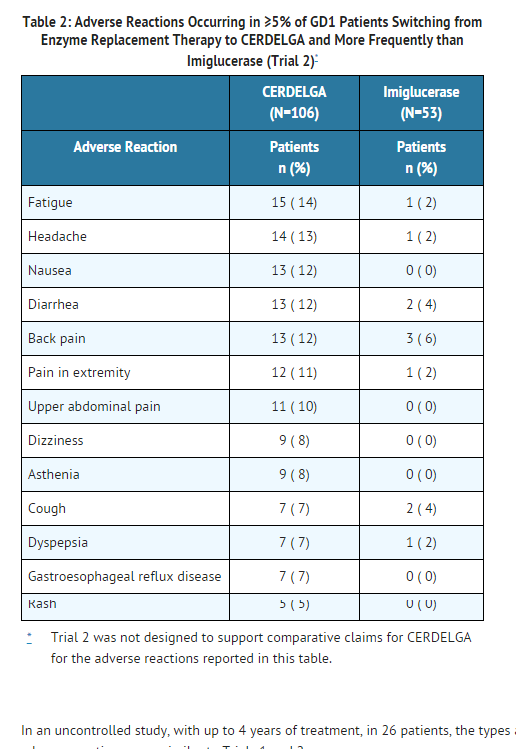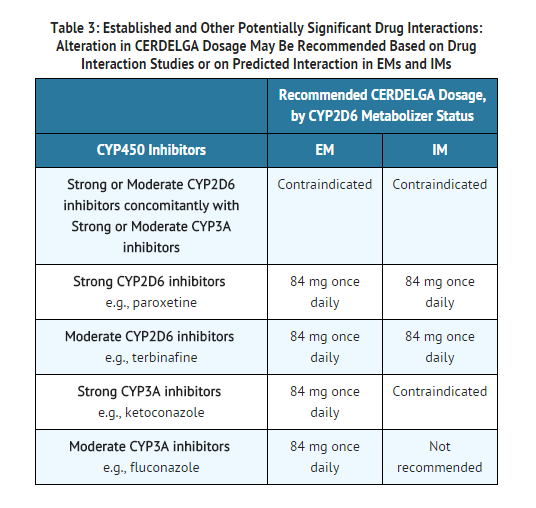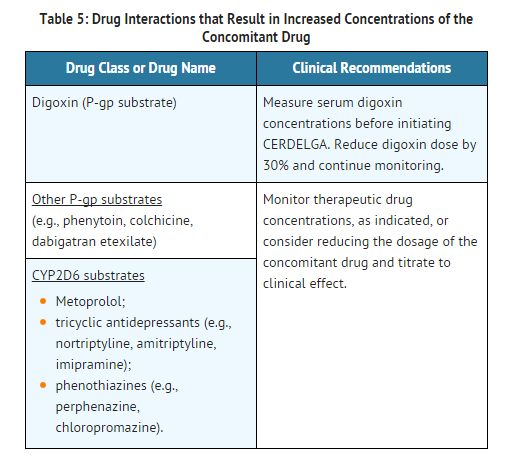Eliglustat
Editor-In-Chief: C. Michael Gibson, M.S., M.D. [1]; Associate Editor(s)-in-Chief: Kiran Singh, M.D. [2]
Disclaimer
WikiDoc MAKES NO GUARANTEE OF VALIDITY. WikiDoc is not a professional health care provider, nor is it a suitable replacement for a licensed healthcare provider. WikiDoc is intended to be an educational tool, not a tool for any form of healthcare delivery. The educational content on WikiDoc drug pages is based upon the FDA package insert, National Library of Medicine content and practice guidelines / consensus statements. WikiDoc does not promote the administration of any medication or device that is not consistent with its labeling. Please read our full disclaimer here.
Overview
Eliglustat is a {{{drugClass}}} that is FDA approved for the treatment of {{{indication}}}. Common adverse reactions include .
Adult Indications and Dosage
FDA-Labeled Indications and Dosage (Adult)
Indications
- CERDELGA is indicated for the long-term treatment of adult patients with Gaucher disease type 1 (GD1) who are CYP2D6 extensive metabolizers (EMs), intermediate metabolizers (IMs), or poor metabolizers (PMs) as detected by an FDA-cleared test.
Limitations of Use:
- Patients who are CYP2D6 ultra-rapid metabolizers (URMs) may not achieve adequate concentrations of CERDELGA to achieve a therapeutic effect .
- A specific dosage cannot be recommended for those patients whose CYP2D6 genotype cannot be determined (indeterminate metabolizers).
Dosage
Patient Selection
- Select patients with Gaucher disease type 1 based on their CYP2D6 metabolizer status. It is recommended patient genotypes be established using an FDA-cleared test for determining CYP2D6 genotype.
Recommended Adult Dosage
- The recommended dosage of CERDELGA is 84 mg twice daily in CYP2D6 EMs and IMs. The recommended dosage in CYP2D6 PMs is 84 mg once daily; appropriate adverse event monitoring is recommended. The predicted exposures with 84 mg once daily in patients who are CYP2D6 PMs are expected to be similar to exposures observed with 84 mg twice daily in CYP2D6 IMs.
- Some inhibitors of CYP2D6 and CYP3A are contraindicated with CERDELGA depending on the patient's metabolizer status [see CONTRAINDICATIONS (4)]. Co-administration of CERDELGA with other CYP2D6 and CYP3A inhibitors may require dosage adjustment depending on the patient's CYP2D6 metabolizer status to reduce the risk of potentially significant adverse reactions.
- Reduce the dosage of CERDELGA to 84 mg once daily for:
- CYP2D6 EMs and IMs taking strong or moderate CYP2D6 inhibitors
- CYP2D6 EMs taking strong or moderate CYP3A inhibitors
DOSAGE FORMS AND STRENGTHS
- CERDELGA is supplied as 84 mg hard gelatin capsules, with a pearl blue-green opaque cap and pearl white opaque body imprinted with "GZ02" in black. Each capsule contains 100 mg eliglustat tartrate, which is equivalent to 84 mg of eliglustat.
Off-Label Use and Dosage (Adult)
Guideline-Supported Use
There is limited information regarding Off-Label Guideline-Supported Use of Eliglustat in adult patients.
Non–Guideline-Supported Use
There is limited information regarding Off-Label Non–Guideline-Supported Use of Eliglustat in adult patients.
Pediatric Indications and Dosage
FDA-Labeled Indications and Dosage (Pediatric)
There is limited information regarding FDA-Labeled Use of Eliglustat in pediatric patients.
Off-Label Use and Dosage (Pediatric)
Guideline-Supported Use
There is limited information regarding Off-Label Guideline-Supported Use of Eliglustat in pediatric patients.
Non–Guideline-Supported Use
There is limited information regarding Off-Label Non–Guideline-Supported Use of Eliglustat in pediatric patients.
Contraindications
- CERDELGA is contraindicated in the following patients due to the risk of significantly increased eliglustat plasma concentrations which may result in prolongation of the PR, QTc, and/or QRS cardiac intervals that could result in cardiac arrhythmias. See TABLE 3 and TABLE 4 for examples of drugs in each of the categories described:
EMs or IMs taking a strong or moderate CYP2D6 inhibitor concomitantly with a strong or moderate CYP3A inhibitor. IMs or PMs taking a strong CYP3A inhibitor.
Warnings
Drug-Drug Interactions
- Eliglustat is a CYP2D6 and CYP3A substrate. Drugs that inhibit CYP2D6 and CYP3A metabolism pathways may significantly increase the exposure to eliglustat and result in prolongation of the PR, QTc, and/or QRS cardiac intervals that could result in cardiac arrhythmias. Some drugs that are inhibitors of CYP2D6 and CYP3A are contraindicated with CERDELGA depending on the patient's CYP2D6 metabolizer status . See TABLE 3 and TABLE 4 for other potentially significant drug interactions.
ECG Changes and Potential for Cardiac Arrhythmias
- Use of CERDELGA in patients with pre-existing cardiac conditions has not been studied during clinical trials. Because CERDELGA is predicted to cause increases in ECG intervals (PR, QTc, and QRS) at substantially elevated eliglustat plasma concentrations, use of CERDELGA is not recommended in patients with pre-existing cardiac disease (congestive heart failure, recent acute myocardial infarction, bradycardia, heart block, ventricular arrhythmia), long QT syndrome, and in combination with Class IA (e.g., quinidine, procainamide) and Class III (e.g., amiodarone, sotalol) antiarrhythmic medications
Adverse Reactions
Clinical Trials Experience
- Because clinical trials are conducted under widely varying conditions, adverse reaction rates observed in the clinical trials of a drug cannot be directly compared to rates in the clinical trials of another drug and may not reflect the rates observed in practice.
- The most common adverse reactions to CERDELGA (occurring in ≥10% of the 126 GD1 patients treated with CERDELGA across Trials 1 and 2) were fatigue, headache, nausea, diarrhea, back pain, pain in extremities, and upper abdominal pain.
The adverse reaction profile of CERDELGA is based on two controlled studies, Trials 1 and 2. Table 1 presents the profile from the 9-month double-blind, randomized, placebo-controlled trial of 40 treatment-naïve patients (Trial 1). Patients were between the ages of 16 and 63 on the date of the first dose of study drug, and included 20 males and 20 females.

- Table 2 presents the profile from the 12-month open-label, randomized, imiglucerase-controlled trial of 159 treated patients switching from enzyme replacement therapy (ERT) (Trial 2). Patients were between the ages of 18 and 69 on the date of the first dose of CERDELGA, and included 87 females and 72 males.

In an uncontrolled study, with up to 4 years of treatment, in 26 patients, the types and incidences of adverse reactions were similar to Trials 1 and 2.
Postmarketing Experience
There is limited information regarding Postmarketing Experience of Eliglustat in the drug label.
Cardiovascular
Digestive
Endocrine
Hematologic and Lymphatic
Metabolic and Nutritional
Musculoskeletal
Neurologic
Respiratory
Skin and Hypersensitivy Reactions
Special Senses
Urogenital
Miscellaneous
Drug Interactions
Potential for Other Drugs to Affect CERDELGA
Eliglustat is a CYP2D6 and CYP3A substrate.
CYP2D6 and CYP3A Inhibitors
- Drugs that inhibit CYP2D6 and CYP3A pathways may significantly increase the exposure to eliglustat and result in prolongation of the PR, QTc, and/or QRS cardiac interval which could result in cardiac arrhythmias:
- Some inhibitors of CYP2D6 and CYP3A are contraindicated with CERDELGA depending on the patient's CYP2D6 metabolizer status.
- Co-administration of CERDELGA with other CYP2D6 and CYP3A inhibitors may require dosage adjustment depending on the patient's CYP2D6 metabolizer status to reduce the risk of potential significant adverse reactions.


Use in Specific Populations
Pregnancy
Pregnancy Category (FDA):
There is no FDA guidance on usage of Eliglustat in women who are pregnant.
Pregnancy Category (AUS):
- Australian Drug Evaluation Committee (ADEC) Pregnancy Category
There is no Australian Drug Evaluation Committee (ADEC) guidance on usage of Eliglustat in women who are pregnant.
Labor and Delivery
There is no FDA guidance on use of Eliglustat during labor and delivery.
Nursing Mothers
There is no FDA guidance on the use of Eliglustat with respect to nursing mothers.
Pediatric Use
- Safety and effectiveness in pediatric patients have not been established.
Geriatic Use
There is no FDA guidance on the use of Eliglustat with respect to geriatric patients.
Gender
There is no FDA guidance on the use of Eliglustat with respect to specific gender populations.
Race
There is no FDA guidance on the use of Eliglustat with respect to specific racial populations.
Renal Impairment
- There is no dosage adjustment required for patients with mild renal impairment. CERDELGA has not been studied in patients with moderate to severe renal impairment or end-stage renal disease (ESRD). Use of CERDELGA in these patients is not recommended.
Hepatic Impairment
- CERDELGA has not been studied in patients with hepatic impairment. Use of CERDELGA is not recommended in all stages of hepatic impairment or cirrhosis.
Females of Reproductive Potential and Males
There is no FDA guidance on the use of Eliglustat in women of reproductive potentials and males.
Immunocompromised Patients
There is no FDA guidance one the use of Eliglustat in patients who are immunocompromised.
Administration and Monitoring
Administration
- Oral
- Intravenous
Monitoring
There is limited information regarding Monitoring of Eliglustat in the drug label.
- Description
IV Compatibility
There is limited information regarding IV Compatibility of Eliglustat in the drug label.
Overdosage
- The highest eliglustat plasma concentration experienced to date occurred in a single-dose, dose escalation study in healthy subjects, in a subject taking a dose equivalent to approximately 21 times the recommended dose for GD1 patients. At the time of the highest plasma concentration (59-fold higher than normal therapeutic conditions), the subject experienced dizziness marked by disequilibrium, hypotension, bradycardia, nausea, and vomiting.
- In the event of acute overdose, the patient should be carefully observed and given symptomatic and supportive treatment.
- Hemodialysis is unlikely to be beneficial given that eliglustat has a large volume of distribution
Pharmacology
There is limited information regarding Eliglustat Pharmacology in the drug label.
Mechanism of Action
- Gaucher disease is caused by a deficiency of the lysosomal enzyme acid β-glucosidase. Acid β-glucosidase catalyzes the conversion of the sphingolipid glucocerebroside into glucose and ceramide. The enzymatic deficiency causes an accumulation of glucosylceramide (GL-1) primarily in the lysosomal compartment of macrophages, giving rise to foam cells or "Gaucher cells". CERDELGA is a specific inhibitor of glucosylceramide synthase (IC50 = 10 ng/mL), and acts as a substrate reduction therapy for GD1. In clinical trials CERDELGA reduced spleen and liver size, and improved anemia and thrombocytopenia.
- In this lysosomal storage disorder (LSD), clinical features are reflective of the accumulation of Gaucher cells in the liver, spleen, bone marrow, and other organs. The accumulation of Gaucher cells in the liver, spleen, and bone marrow leads to organomegaly and skeletal disease. Presence of Gaucher cells in the bone marrow and spleen lead to clinically significant anemia and thrombocytopenia.
Structure
CERDELGA (eliglustat) capsules contain eliglustat tartrate, which is a small molecule inhibitor of glucosylceramide synthase that resembles the ceramide substrate for the enzyme, with the chemical name N-((1R,2R)-1-(2,3-dihydrobenzo[b][1,4]dioxin-6-yl)-1-hydroxy-3-(pyrrolidin-1-yl)propan-2-yl)octanamide (2R,3R)-2,3-dihydroxysuccinate. Its molecular weight is 479.59, and the empirical formula is C23H36N2O4+½(C4H6O6) with the following chemical structure:

Each capsule of CERDELGA for oral use contains 84 mg of eliglustat, equivalent to 100 mg of eliglustat tartrate (hemitartrate salt). The inactive ingredients are microcrystalline cellulose, lactose monohydrate, hypromellose and glyceryl behenate, gelatin, candurin silver fine, yellow iron oxide, and FD&C blue 2.
Pharmacodynamics
Electrocardiographic Evaluation
- QTc interval prolongation was studied in a double-blind, single dose, placebo- and positive-controlled crossover study in 42 healthy subjects. Concentration-related increases were observed for the placebo-corrected change from baseline in the PR, QRS, and QTc intervals. Based on PK/PD modeling, eliglustat plasma concentrations of 500 ng/mL are predicted to cause mean (upper bound of the 95% one-sided confidence interval) increases in the PR, QRS, and QTcF intervals of 22 (26), 7 (10), and 13 (19) msec, respectively. At the highest geometric mean concentrations of 237 ng/mL following a single supratherapeutic dose tested in the thorough QT study, CERDELGA did not prolong the QT/QTc interval to any clinically relevant extent.
Pharmacokinetics
- At a given dose, the systemic exposure (Cmax and AUC) depends on the CYP2D6 phenotype. In CYP2D6 EMs and IMs, the eliglustat pharmacokinetics is time-dependent and the systemic exposure increases in a more than dose proportional manner. After multiple oral doses of 84 mg twice daily in EMs, eliglustat systemic exposure (AUC0-12) increased up to about 2-fold at steady state compared to after the first dose (AUC0-∞). The pharmacokinetics of eliglustat in CYP2D6 PMs is expected to be linear and time-independent. Compared to EMs, the systemic exposure following 84 mg twice daily at steady state is 7- to 9-fold higher in PMs.
Absorption
- In CYP2D6 EMs, median time to reach maximum plasma concentrations (tmax) occurs at 1.5 to 2 hours following multiple doses of CERDELGA 84 mg twice daily. The corresponding mean Cmax values range from 12.1 to 25.0 ng/mL in EMs. The mean AUCtau values range from 76.3 to 143 hr*ng/mL in EMs. The Cmax and AUCtau in one IM subject receiving multiple doses of CERDELGA 84 mg two time daily was 44.6 ng/mL and 306 hr*ng/mL, respectively. The oral bioavailability is low in EMs (<5%) following single dose of CERDELGA 84 mg due to significant first-pass metabolism.
- In PMs, median tmax occurs at 3 hours following multiple doses of CERDELGA 84 mg twice daily. The corresponding mean Cmax and AUCtau values range from 113 to 137 ng/mL and 922 to 1057 hr*ng/mL, respectively.
Oral dosing of CERDELGA 84 mg once daily has not been studied in PMs. The predicted Cmax and AUC0-24hr in PMs using physiologically-based pharmacokinetic (PBPK) model with 84 mg once daily are 75 ng/mL and 956 hr*ng/mL, respectively.
- Administration of CERDELGA with a high fat meal resulted in a 15% decrease in Cmax but no change in AUC. Food does not have a clinically relevant effect on eliglustat pharmacokinetics.
Distribution
- Eliglustat is moderately bound to human plasma proteins (76 to 83%). In the blood, it is mainly distributed in plasma and not red blood cells. After intravenous (IV) administration, the volume of distribution of eliglustat was 835 L in CYP2D6 EMs, suggesting wide distribution to tissues (CERDELGA is only for oral use).
Metabolism and Elimination
- CERDELGA is extensively metabolized with high clearance, mainly by CYP2D6 and to a lesser extent CYP3A4. Primary metabolic pathways of eliglustat involve sequential oxidation of the octanoyl moiety followed by oxidation of the 2,3-dihydro-1,4-benzodioxane moiety, or a combination of the two pathways, resulting in multiple oxidative metabolites. No active metabolites have been identified.
- After oral administration of 84 mg [14C]-eliglustat, the majority of the administered dose is excreted in urine (41.8%) and feces (51.4%), mainly as metabolites. After 42 mg IV administration in healthy volunteers, mean (CV%) of eliglustat total body clearance was 88 L/h (8.8%) in CYP2D6 EMs (CERDELGA is only for oral use). Following multiple oral doses of CERDELGA 84 mg twice daily, eliglustat terminal elimination half-life (T1/2) was approximately 6.5 hours in EMs and 8.9 hours in PMs.
Specific Populations
- Based on population PK analysis, there was no effect of mild renal impairment on eliglustat PK. Furthermore, gender, body weight, age, and race had no clinically relevant impact on the pharmacokinetics of eliglustat.
Drug Interactions - Effect of Other Drugs on CERDELGA
- In vitro, eliglustat is metabolized primarily by CYP2D6 and to a lesser extent by CYP3A4. Eliglustat is also a substrate of P-glycoprotein (P-gp).
- Co-administration of CERDELGA with CYP2D6 Inhibitors
- Systemic exposure (Cmax and AUCtau) of eliglustat increased 7.0-fold and 8.4-fold, respectively, following co-administration of CERDELGA 84 mg twice daily with paroxetine (a strong CYP2D6 inhibitor) 30 mg once daily in EMs (N=30), respectively.
- Simulations using PBPK models suggested that paroxetine may increase the Cmax and AUCtau of eliglustat 2.1- and 2.3-fold in IMs, respectively.
- Compared to paroxetine, the effects of terbinafine (a moderate inhibitor of CYP2D6) on the exposure of eliglustat in EMs or IMs were predicted to be smaller. Simulations using PBPK models suggested that terbinafine may increase the Cmax and AUCtau of eliglustat 3.8- and 4.5-fold in EMs, respectively. Both Cmax and AUCtau increased 1.6-fold in IMs.
Co-administration of CERDELGA with CYP3A Inhibitors
CYP2D6 EMs and IMs:
- Following co-administration of CERDELGA 84 mg twice daily with ketoconazole (a strong CYP3A inhibitor) 400 mg once daily, the systemic exposure (Cmax and AUCtau) of eliglustat increased 4.0-fold and 4.4-fold in EMs (N=31).
- Simulations using PBPK models suggested that ketoconazole may increase the Cmax and AUCtau of eliglustat 4.4- and 5.4-fold in IMs, respectively.
- Compared to ketoconazole, the effects of fluconazole (a moderate inhibitor of CYP3A) on the exposure of eliglustat in EMs or IMs were predicted to be smaller. Simulations using PBPK models suggested that fluconazole may increase the Cmax and AUCtau of eliglustat 2.8- and 3.2-fold in EMs, respectively, and 2.5- to 2.9-fold in IMs, respectively.
CYP2D6 PMs:
- The effect of CYP3A inhibitors on the systemic exposure of eliglustat in PMs has not been evaluated in clinical studies. Simulations using PBPK models suggest that ketoconazole may increase the Cmax and AUC0-24h of eliglustat 4.3- and 6.2-fold when co-administered with CERDELGA 84 mg once daily in PMs. Simulations using PBPK models suggested that fluconazole may increase the Cmax and AUC0-24h of eliglustat 2.4- and 3.0-fold, respectively, when co-administered with CERDELGA 84 mg once daily.
Co-administration of CERDELGA with CYP2D6 and CYP3A inhibitors
- Simulations using PBPK models suggested that concomitant use of CERDELGA 84 mg twice daily with paroxetine and ketoconazole may increase the Cmax and AUCtau of eliglustat 16.7- and 24.2-fold in EMs, respectively. The predicted Cmax and AUCtau of eliglustat increased 7.5- to 9.8-fold in IMs, respectively.
- Simulations using PBPK models suggested that concomitant use of CERDELGA 84 mg twice daily with terbinafine and fluconazole may increase the Cmax and AUCtau of eliglustat 10.2- and 13.6-fold in EMs. The predicted Cmax and AUCtau of eliglustat increased 4.2- to 5.0-fold in IMs, respectively.
Effect of CYP3A inducers on Eliglustat PK
- Systemic exposures (Cmax and AUCtau) of eliglustat decreased by approximately 90% in EMs and IMs, following co-administration of CERDELGA 127 mg twice daily with rifampin (a strong CYP3A inducer) 600 mg PO once daily. The only approved dose of CERDELGA is 84 mg. Systemic exposures of eliglustat decreased by approximately 95% following co-administration of CERDELGA 84 mg twice daily with rifampin 600 mg PO once daily in PMs.
Effect of OATP (organic anion transporting polypeptide) Inhibitors on Eliglustat PK
- Systemic exposures of eliglustat were similar with or without co-administration of single 600 mg IV dose of rifampin (a potent OATP inhibitor) regardless of subjects' CYP2D6 phenotypes.
Effect of P-gp Inhibitors on Eliglustat PK
- The effect of P-gp inhibitors on the systemic exposure of eliglustat has not been studied clinically.
Effect of Gastric pH-Modifying Agents on Eliglustat PK
- Gastric pH-modifying agents (Maalox®, Tums®, Protonix®) did not have a clinically relevant effect on eliglustat exposure.
Drug Interactions - Effect of CERDELGA on the PK of Other Drugs
- Eliglustat is an inhibitor of P-gp and CYP2D6.
- Following multiple doses of CERDELGA 127 mg twice daily, systemic exposures (Cmax and AUC) to metoprolol (a CYP2D6 substrate) increased compared to metoprolol administration alone. Mean Cmax and AUC increased by 1.7- and 2.3-fold, respectively, in EMs and by 1.2- and 1.6-fold, respectively in IMs. The only approved dose of CERDELGA is 84 mg.
- Following multiple doses of CERDELGA 127 mg twice daily in EMs and IMs or 84 mg twice daily in PMs, systemic exposures (Cmax and AUC) to digoxin (a P-gp substrate, with narrow therapeutic index) increased compared to digoxin administration alone. Mean Cmax and AUC increased by 1.7- and 1.5-fold, respectively. The only approved dose of CERDELGA is 84 mg.
- In vitro, eliglustat is a weak inhibitor of CYP3A. Repeated doses of CERDELGA 84 mg twice daily did not change the exposures to norethindrone (1.0 mg) and ethinyl estradiol (0.035 mg). Therefore, CERDELGA is not expected to impact the efficacy or safety of oral contraceptives containing norethindrone and ethinyl estradiol.
Nonclinical Toxicology
There is limited information regarding Nonclinical Toxicology of Eliglustat in the drug label.
Clinical Studies
There is limited information regarding Clinical Studies of Eliglustat in the drug label.
How Supplied
Storage
There is limited information regarding Eliglustat Storage in the drug label.
Images
Drug Images
{{#ask: Page Name::Eliglustat |?Pill Name |?Drug Name |?Pill Ingred |?Pill Imprint |?Pill Dosage |?Pill Color |?Pill Shape |?Pill Size (mm) |?Pill Scoring |?NDC |?Drug Author |format=template |template=DrugPageImages |mainlabel=- |sort=Pill Name }}
Package and Label Display Panel
{{#ask: Label Page::Eliglustat |?Label Name |format=template |template=DrugLabelImages |mainlabel=- |sort=Label Page }}
Patient Counseling Information
There is limited information regarding Patient Counseling Information of Eliglustat in the drug label.
Precautions with Alcohol
- Alcohol-Eliglustat interaction has not been established. Talk to your doctor about the effects of taking alcohol with this medication.
Brand Names
Look-Alike Drug Names
Drug Shortage Status
Price
References
The contents of this FDA label are provided by the National Library of Medicine.
{{#subobject:
|Page Name=Eliglustat
|Pill Name=No image.jpg
|Drug Name=
|Pill Ingred=|+sep=;
|Pill Imprint=
|Pill Dosage={{{dosageValue}}} {{{dosageUnit}}}
|Pill Color=|+sep=;
|Pill Shape=
|Pill Size (mm)=
|Pill Scoring=
|Pill Image=
|Drug Author=
|NDC=
}}
{{#subobject:
|Label Page=Eliglustat |Label Name=Eliglustat11.png
}}
{{#subobject:
|Label Page=Eliglustat |Label Name=Eliglustat11.png
}}